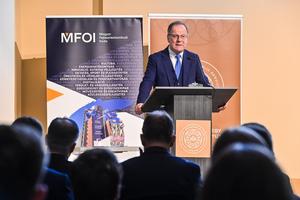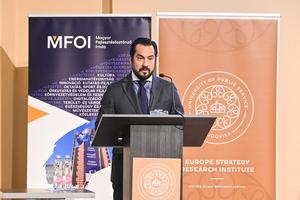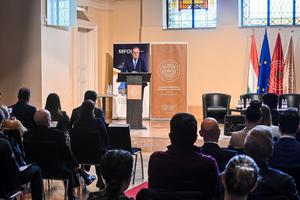„The future of cohesion policy will be one of the most important topics of the Hungarian EU presidency," highlighted Tibor Navracsics, Minister for Public Administration and Regional Development, at the first Cohesion Summit 2024 held at the Ludovika University of Public Service (LUPS) on April 18th.
The conference focused on critical areas such as managing regional disparities, promoting comprehensive cohesion, and adapting policies to changing economic environments, with particular attention to bridging the innovation gap in less developed regions. This was in consideration of the lessons from the Ninth Cohesion Report of the European Commission and the report presented by former Italian Prime Minister Enrico Letta on the future of the European single market.
Pier Paolo Pigozzi, the Vice-Rector for International Affairs, in his opening speech, emphasised that this first event of its kind was organised in Budapest, at the Ludovika Campus, with the participation of both public and academic sector stakeholders, realised in the frame of the University's EU Presidency Strategy. He highlighted that the University organises many courses and research focused on the European Union and international relations, adding that as a knowledge centre, the University can significantly contribute to the success of Hungary's EU Council Presidency in the second half of 2024. The Summit aimed to explore innovative strategies for sustainable growth, using the outcomes of ongoing European debates to shape a forward-looking dialogue on enhancing cohesion within the constantly evolving framework of the EU single market.
In his presentation, Minister Tibor Navracsics emphasised that cohesion policy is one of the EU's most successful policies, and Hungary is keen on its future success. "The stronger the cohesion in a country and society, the better the competitiveness," stated the Minister. He stressed that the main task of territorial-based cohesion policy is the convergence of lagging areas. It was mentioned that Hungary has surpassed some old EU member states like Greece in development rankings and is highly competitive with Portugal. The strategic goal of the Hungarian government is for the country to be among the top five most livable countries in the EU by 2030. To achieve this, a development policy is needed that ensures the retention of rural populations and the creation of livable rural and urban areas.
Gábor Zupkó, the head of the European Commission's Representation in Hungary, addressed that cohesion is the foundation that supports the typical house, in this case, Europe. He stated that cohesion policy plays a central role in challenges such as the energy crisis, support for small and medium-sized enterprises and households. He sees a need to uncover the "secret sources" that lie within regional policy, sustainability, and innovation strategies.
Mónika Hencsey, Director of the European Commission's Directorate-General for Regional and Urban Policy, emphasised that focusing on regional and local conditions must be of primary importance. She highlighted that geopolitical challenges require flexibility from different member states while stressing the need to emphasise partnership in the future.
Emil Boc, Chair of the COTER of the European Committee of the Regions, emphasised the need to avoid treating cohesion policy merely as a functional policy reacting to a specific emergency.
In a panel discussion on the cornerstones of cohesion policy, moderated by Viktória Lilla Pató, a researcher at the LUPS Eötvös József Research Center, Europe Strategy Research Institute, alongside Tibor Navracsics and Mónika Hencsey, Bernadett Petri, the Commissioner responsible for the coordination of directly managed EU funds at the Ministry for Public Administration and Territorial Development, also joined. The participants discussed how competitiveness can be developed and how they see the future of cohesion. It was noted that flexibility and adaptability in the distribution of structural funds are necessary, and the goal should not only be convergence but improving competitiveness, which can also be good when the principles of cohesion are considered.
In the subsequent panel discussion, moderated by Judit Szakos, a researcher at the John Lukacs Institute, LUPS, and attended by Rita Marques, leader of the Harnessing Talent Platform territorial working group of the European Commission, and János Matuz, senior advisor at the Hungarian Development Promotion Office, they discussed best practices, innovative approaches, and case studies. The conversation circled the challenges and solutions for reducing economic and social disparities between EU regions, highlighting the importance of innovation and digitalisation.
In the third panel discussion, moderated by Zsuzsanna Kondor, professor at LUPS, and attended by Sebastian Bourdain, professor at Normandy Business School, Áron Szakács, managing director of the Széchenyi Program Office, Csaba Zalai, a professor at LUPS, and Elke Dall, researcher at the Social Innovation Center, the participants shared their thoughts on what EU cohesion policy might look like after 2027. They believe redefining our resources towards productivity is necessary and establishing social practices that can help member states work together more effectively.
The video recording of the discussion is available at the following link: https://www.youtube.com/watch?v=AnqYYN3NcFA






